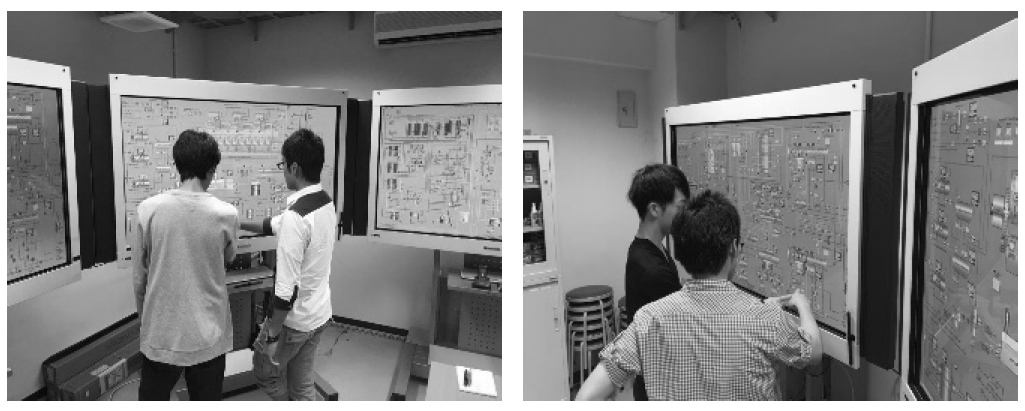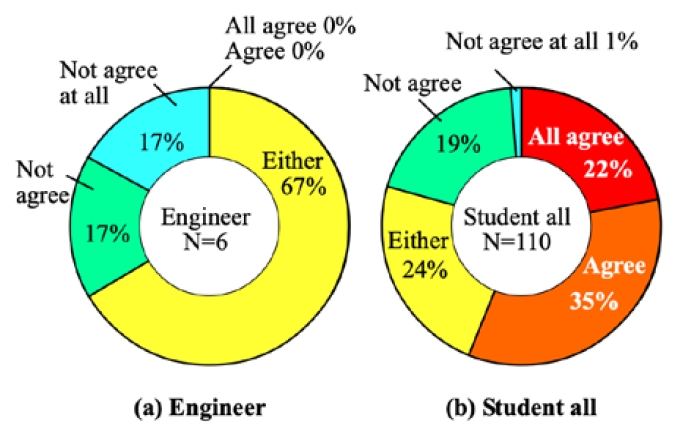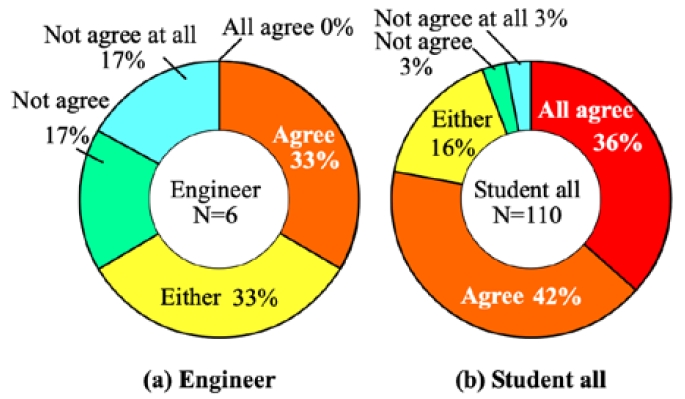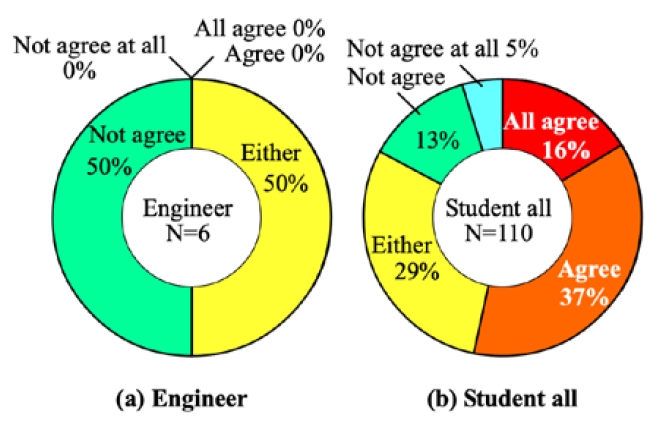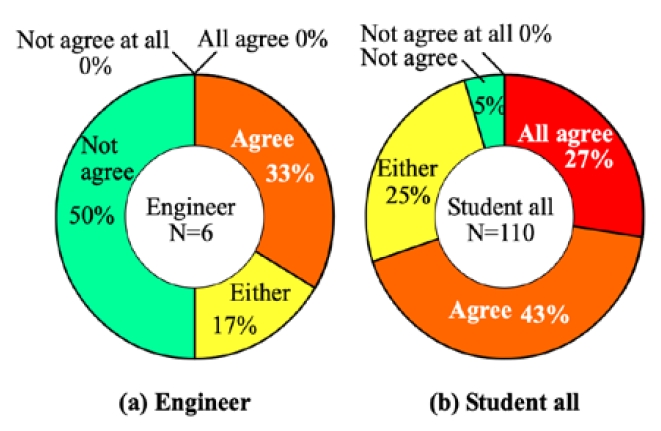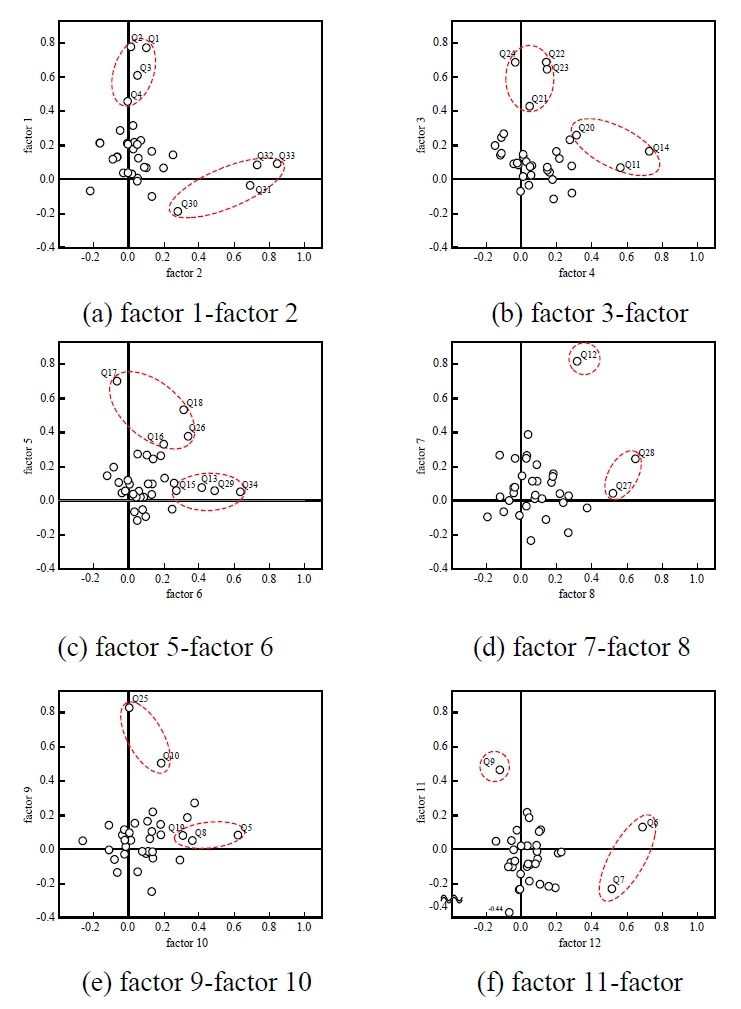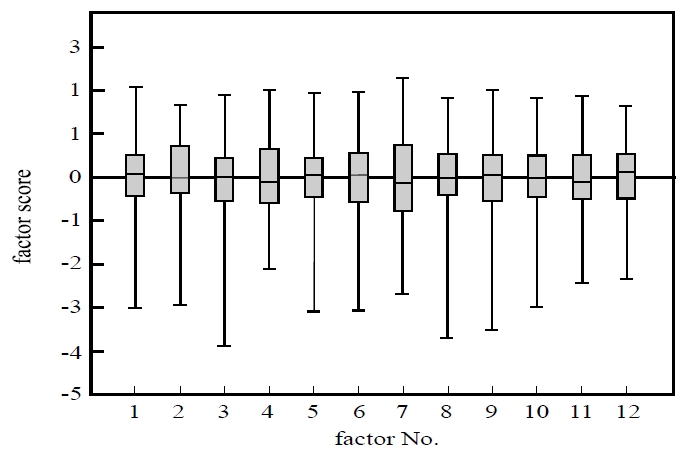
A study of difficulty factors in piping diagram reading in an engine room simulator environment
Copyright ⓒ The Korean Society of Marine Engineering
This is an Open Access article distributed under the terms of the Creative Commons Attribution Non-Commercial License (http://creativecommons.org/licenses/by-nc/3.0), which permits unrestricted non-commercial use, distribution, and reproduction in any medium, provided the original work is properly cited.
Abstract
Demand for an engine room simulator has recently increased. Several manufacturers provide 3-dimensional animation or computer graphic imaging for application in virtual reality technology. Furthermore, educational tool hardware are improving on a daily basis. As educational institute researchers, we consider the planning of effective training exercises based on a simulated environment. In addition to hardwarerelated issues, softwarerelated issues also exist in educational situations. One of the major difficulties associated with solving these problems is adjusting the task level according to the skill of the student, for which it must be known if the students are in fact finding any difficulty. We therefore conducted a questionnaire survey and factor analysis to detect the latent factors that affect the degree of difficulty, using data gathered via a questionnaire survey. Based on the findings of a questionnaire survey, we presented the difficulty factors encountered by students in understanding an engine room piping diagram.
Keywords:
Engine room simulator, Difficulty of reading piping diagram1. Introduction
Since implementation of the “The International Convention on Standards of Training, Certification and Watchkeeping for Seafarers, 1978” (STCW) amendment in Manila, 2010, maritime educational institutes and universities have numerous conducted resource management exercises. Engine room simulator training is an approved and preferred method of demonstrating competence of engineer. The criteria for evaluating competence is further strengthened by the STCW Convention regulation I/12; thus, the demands on simulator use have increased. In Kobe University, an engine room simulator (ERS) was installed in 2010. At the Australian Maritime College (AMC), the University of Tasmania, a full mission engine room simulator was installed in 2016. Both the institutes use these simulators for training, according to competency requirements.
The simulators are not only used by teachers who belong to the educational institute but also by several researchers for their investigations. Some researchers have attempted to improve the simulator exercise for improving students’ understanding for engine plant.
G. Lokuketagoda, an author of this paper, highlighted the benefits of computer-based simulator training in areas other than the normal engine room, where watch-keeping exercises are performed by depending on trainees’ leaning speed [1]. I. Deguchi and Y. Emi introduced engine room simulators installed on Japanese training ships [2][3] They mentioned that these simulators are advantageous as they can be used as onboard simulators for conducting training exercises utilizing a real engine plant. Generally, the engine room equipment is installed in the simulator and various piping diagrams are displayed on it. Therefore, each trainee is required to understand these piping diagrams before taking the exercise. In the present study, we focus on the difficulty of interpreting the piping diagrams during an engine room simulation and investigate the potential common difficulties faced by students when trying to understand the diagrams.
2. Application of ERS to educational situations
2. 1 Simulator exercise
Educational institutes conduct engine room resource management (ERM) exercises for seafarers. To perform these exercises, the trainees have to obtain suitable knowledge and skills for operating the engine plant and its machinery. In Kobe University, students belonging to the 2nd and 3rd year attend classroom lessons and perform practice exercises for improving their knowledge and skills regarding basic engine plant and machinery operation. Furthermore, they attend ERM training when they reach 4th year. Figure 1 depicts a simulator exercise scene at the Kobe university. After first discussing with one another, they start the pumps and operate the valves to start the main engine; the students seen in the picture are 2nd year undergraduates.
Most students may feel bored when the task is too easy, whereas, when a task is too difficult, they may even stop trying to solve it altogether, both of which will hamper the student’s motivation. This natural human behavior was highlighted by A. Stuiver et al. as the ceiling effect [4] of biological response.
In simulator exercises, setting of the difficulty level is important for an effective training session; particularly if the student is not a qualified marine engineer. At the basic level, the knowledge and skills of the trainee concerning the engine plant may not be sufficient to solve the task, which is required by the competence requirements of the STCW convention.
2. 2 Cognitive categories at engine room simulator exercise
The purpose of ERS exercises is predominantly to manage the machinery plant system and operate them effectively and safely. The educational goal of these ERS exercises must enable the trainees to identify the cognitive tasks using Bloom's taxonomy [5], defined as the process and knowledge dimensions. The cognitive process is categorized as follows: remember, understand, apply, analyze, evaluate, and create. The knowledge dimension is split into four categories: factual, conceptual, procedural, and meta-cognitive knowledge.
As these keywords are used in the operational level of competency (STCW, TableA-III/1), it is necessary for the students to obtain factual knowledge of machinery, piping systems, diagram symbols, and knowledge for reading diagrams. During the ERS exercises, trainees employ their knowledge and skills by remembering and understanding. Furthermore, at the start of the engine operation, trainees are expected to know the energy flow in the piping system, operational procedure, and machinery operations as procedural knowledge. This procedural knowledge is applied by the trainee for correct and safe machinery operation. Finally, at the management competency level (STCW, TableA-III/2), the knowledge of conceptual relations between the engine and running environment, including voyage schedule and weather and sea conditions, are used for analysis and evaluation.
Therefore, pipe diagram reading requires remembering and understanding of factual knowledge. These procedures are considered basic knowledge in marine engine plant practices.
3. Questionnaire for understanding student difficulty
There is a difference in knowledge and skill level between a student and experienced engineer. In addition, each year grade student knowledge level does not equal that of past student too. Unfortunately, the hardware component of the engine room simulator is difficult to customize for each trainee level after it is installed.
In the existing engine room simulator, engine room equipment is illustrated as a piping diagram on large liquid crystal displays. During the student exercises, the authors often noted that some students were only observing their friend's operations. It may be that they are not good at tracing pipelines or searching for pipe connections; this especially applies to university students without sufficient sea experience. Furthermore, it is difficult to effectively solve problems in the engine room simulator environment if they do not have high motivation.
We conducted a research questionnaire concerning reading difficulty in students’ piping diagram understanding.
The questionnaire consisted of 34 questions, created by the authors based on training ship instructor experience. The questionnaire is presented in Table 1.
The first part of the questionnaire concerns line drawings, the middle part of the questionnaire concerns questions for figures or expressions, and the final part of the questionnaire concerns subjective opinions, which depend on the participant's experience of reading piping diagrams.
For each question, the participant records 1 to 5; 1 means “do not agree at all,” 3 is “either,” 5 is “completely agree.”
Prior to this survey, we obtained informed consent from the participants to protect their personal information.
4. Result and discussion
We conducted the questionnaire survey involving students who had previously attended the engine room simulator exercise. Table 2 list the participant affiliation and their year in the university.
There is a difference in the knowledge level between school year grades. These differences in knowledge affect the variation in difficulty perception. If we could adjust the cause factor condition, we could successfully change the ERS training difficulty level.
4. 1 Questionnaire results
The question answers follow a typical tendency and hence we focused on the following data for discussion of difficulty. The answers of four engineers who are employed by the training ship of Kobe University, and two doctoral students of maritime sciences, were compared with those of an undergraduate student, and the student tendencies were analyzed.
Q4 is “I am bored by tracing longer lines.” We theorized that this question would demonstrate the student's experience of reading piping diagrams in the past.
The results demonstrate that half of the students had a negative experience in the past. In fact, all the participants had one to three months of sea experience as trainees. Specifically, most 4th year students had attended a piping system survey on a training ship.
This question was planned to remove the priority of illustration quality. Illustration familiarization is different between people and may depend on personal competence. However, most students need illustration, which facilitates familiarization. If a student has a chance of seeing something several times, their understanding of some things may increase.
Q5 is “Familiarization of illustration is important.” This answer seems related to the former session, regarding answers to Q4; as seen in Figure 3, students had a positive impression regarding illustrations and they may want to improve their illustration understanding.
Q6 is “I may hate message in English.” This result may demonstrate the mind of a typical student. It appears that Japanese students are not good at understanding foreign languages; in general, they are reticent about speaking English in their daily life.
Q8 is “I find illustrations more familiar than a line.” We assume there is a relation between this and Q4/Q5. We predicted that some negative experience may later result in the student changing preference.
Adjusting the space ratio between the illustration and pipings may be effective for improving the motivation of the students in understanding piping diagrams.
Q10 is “I may hate mechanical image.” This question is targeted to confirm the participant’s confidence level as a marine engineer; e.g., the students may want to be engineers but may not necessarily say "I like mechanical things". One reason for this may be that they are shy or reluctant to express their interest. It may be difficult for a questionnaire to reflect the real thinking patterns of the participants.
The participants belong to the marine engineering division in Kobe University. This result demonstrates that the students either lost their engineering motivation or answered incorrectly.
4. 2 Identification of latent factors
We attempted to identify the latent factors in piping diagram reading difficulty via the students’ questionnaire answers.
We analyzed the student’s questionnaire answers to determine a correlation between each questionnaire item. We expected to identify the latent factors in the students’ piping diagram reading difficulty.
Table 3 shows a pair of questions that were calculated as having a high correlation. There were 17 items in the questionnaire that had a relation score greater than 0.4.
In Table 3, it can be seen the question pairs or ranges near the order number items illustrate a high correlation tendency. This questionnaire list consists of 3 parts; the first, middle, and end. There is a correlation between the items listed next to each other and also between other individual items, e.g., Q10 – Q25, Q12 - Q21, and Q12 - Q27. These cases illustrate that answer tendency is similar with each item. For example, the correlation of Q10 - Q25 suggests that a student who has a negative impression of mechanical images is not good at understanding important machinery diagrams. The correlation of Q12 - Q27 suggests that students resent locating a pipeline via familiarization or reading illustrations. These relations imply that there is a causal relationship between each answer.
In the previous section, the correlation was confirmed between questions in different fields and we investigated their common factors. We obtained the common factors via factor analysis, based on the response of the student subjects, using the statistical analysis software IBM, SPSS Statistic19.
“Principal factor analysis” is used as the factor extraction method and the "varimax method” for rotation; the factor load for one factor is maximized by this method. Each factor’s loading for the questions are shown in Figure 7-(a) to 7-(f). The questions with a large factor loading are summarized in Table 4.
As a result of the analysis, 12 common factors were detected. The cumulative contribution ratio of these factors is 70.4 %. Factor scores were calculated for each student and a summary of each is shown in Figure 8.
Except for factors 4, 7, and 11, the factor score was positive at the median of the data. It can be seen that the drawing condition (factor 1) and the motivation for the piping diagram (factor 2)affect the difficulty of reading the diagram. Factor analysiswas used to effectively illustrate the necessity for reading piping diagrams, in addition to drawing and drawing techniques.
In the case of students who did not have sufficient opportunity to gain operational knowledge, the main factor in their lower understanding level may not relate to ability. This factor can potentially solve the problem by allowing further knowledge to be obtained, along with the assumption that solving the problem is not difficult. Increasing the number of lessons or exercises or extending class time may solve these problems.
For students who have no work experience at sea, knowing the engineer's job details, which relates to reading piping diagrams, is one way of increasing their motivation to study. For example, an active duty or retired marine engineer conducting the classroom lesson may be effective in maintaining or increasing reading motivation.
Regarding the drawing condition, factor 1 consisted of line fineness, line crossing, number of lines, and line length. Kobe university’s simulator gathers the many pieces of machinery which comprise an engine plant, and the connecting piping, and displays it on a screen. We propose that factor 1 is caused by this present display method and that the difficulty degree can be adjusted by altering the number of devices or limiting the number of piping lines and length, according to trainees' ability.
In the case of an existing ERS, in which it is difficult to change the drawing condition by altering the hardware components, it may be possible to adjust the difficulty level via the software. When the instructor gives the pipe reading task, we propose that it may be possible to adjust the difficulty by increasing or decreasing the number of pipe routes related to the task.
For example, in the case where the lubricating oil cooler temperature control valve is defective, it is sufficient to only read the lubricating oil path to solve the excessive increase in lubricating oil temperature at the inlet of the main engine. Moreover, in the case of the lubricating oil cooler being insufficiently cooled, two paths require reading owing to the relationship between the lubricating oil path and cooling seawater path at the heat exchanger. We propose that the degree of difficulty can be adjusted by setting the software condition.
5. Conclusion
For planning an effective education system using an engine room simulator, the instructor should set the simulator difficulty based on the trainee’s skill. Therefore, the instructor is required to first understand the abilities of the students for selecting the difficulty level.
The watch-keeping task, in which the student is expected to deliver an efficient performance, was not the only technically difficult exercise. There may be other difficulties faced by the student, depending on his background; e.g., difficulty in understanding the messages, which entirely depends on his ability to understand a foreign language and is not a simulator-related problem.
As an educational method, giving a successful experience to students is effective in improving their study motivation. If a student has had a negative experience whilst sea training, a well-planned simulator training improves the training success; this experience, in turn, may improve their motivation.
The requirements for the simulator are simple. The instructor and the student must correctly respond assuming the simulator as a real marine engine plant. The Russian educational researcher L. S. Vygotsky expressed the student developmental process [6]; in his method, he used a potential level of development, which is set by adult guidance or a capable partner assisting the trainee. In conclusion, we believe the engine room simulator will be an educational tool for effective guidance or collaboration in the domain of problem-solving.
In the present, the participants included not only students who want to be marine engineers but also those who aim to be power plant engineers or a part of the onshore manufacturing industry or; we propose that this simulator can respond appropriately to the requirements of each participant. We will continue collecting research results, which will be further analyzed to meet the needs of engine room simulator users.
Acknowledgments
This research was participated in by students from the graduate school of maritime sciences at Kobe University. We thank the students who volunteered as participants.
Author Contributions
Conceptualization, T. Miwa and G. Lokuketagoda; Methodology, T. Miwa; Formal Analysis & Investigation, N. Takemura; Writing-Original Draft Preparation, N. Takemura and T. Miwa; Writing-Review & Editing, M. Nakamura, M. Uchida, and G. Lokuketagoda; Supervision, M. Uchida.
References
- G. Lokuketagoda, et al., “Enhancing the student learning experience by the use of engine room simulator desktop simulation in STCW competency courses,” Proceedings of the 12th International Conference on Engine Room Simulators (ICERS12), pp. 13-17, 2015.
- Ichiro Deguchi, et al., Report of installation for the onboard type Engine Room Simulator Training on JETS training ships, Proceedings of the International Symposium on Marine Engineering (ISME2017), pp. 511-514, 2107. Available at http://archive.jime.jp/isme/2017/
- Yutaka Emi, et al., Blended Onboard Training Utilizing Onboard ERS on NIST Training Ships, Proceedings of 12th International Conference on Engine Room Simulators (ICERS12), pp. 25-29, 2015. Available at https://www.maritime.itu.edu.tr/icers12/
-
A. Stuiver, K. A. Brookhuis, D. Waard, and B. Mulder, “Short term cardiovascular measures for driver support: Increasing sensitivity for detecting changes in mental workload,” International Journal of Psychophysiology, vol. 92, no. 1, pp. 35-41, 2014.
[https://doi.org/10.1016/j.ijpsycho.2014.01.010]

- L. W. Anderson, et al., A Taxonomy for Learning, Teaching, and Assessing: A Revision of Bloom’s Taxonomy of Educational Objectives, New York, USA: Longman, pp. 27-31, 2001
- L. S. Vygotsky, Mind in Society: The Development of Higher Psychological Processes: Harvard University Press, pp. 84-91, 1978.

